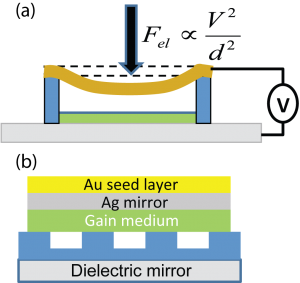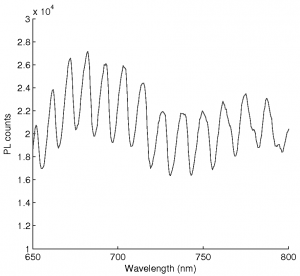MEMS Tunable Organic Laser Cavities
Standard photolithography-based methods for fabricating micro-electromechanical systems (MEMS) present several drawbacks including incompatibility with flexible substrates and limitations to wafer-sized device arrays. Recently our group has demonstrated a new method for rapid fabrication of metallic MEMS that breaks the paradigm of lithographic processing using an economically and dimensionally scalable, large-area microcontact printing method to define 3D electromechanical structures. Here we utilize this MEMS printing method to create tunable optical cavities, with the ultimate goal of creating an electrically color-tunable organic laser. The device concept is shown in Figure 1. The bottom half of the optical cavity is fabricated by forming ridges of polydimethylsiloxane (PDMS) on a dielectric mirror using a silicon master. The top half of the cavity is independently fabricated by thermally evaporating an organic release layer on a planar PDMS substrate followed by layers of Au and Ag, which act both as the top mirror of the cavity and as the flexible MEMS element. The organic lasing medium (DCM) is evaporated on the metallic layers. This layer structure is stamped onto the PDMS ridges followed by a rapid peel-off, forming the structure shown in Figure 1b.
The photoluminescence from the DCM gain layer under 532-nm excitation shows clear evidence of a vertical optical cavity formed between the dielectric mirror and the Ag flexible membrane, demonstrating an optical microcavity formed by a scalable MEMS printing method. The optical resonances of the device can be varied by applying a bias voltage to the top flexible membrane, thus changing the distance between the mirrors (Figure 1a). This structure paves the way to developing color-tunable organic lasers on flexible substrates over large areas using an economical MEMS fabrication technique.
- Figure 1: (a) Optical-cavity tuning by biasing a flexible metal membrane. (b) Structure of MEMS tunable laser device.
- Figure 2: Photoluminescence of the laser dye DCM in a printed optical cavity.
References
- Packard et al. “Contact-Printed Microelectromechanical Systems,” Advanced Materials, vol. 22 pp. 1840-1844 (2010).
- Bulovic et al. “Transform-limited, narrow-linewidth lasing action in organic semiconductor microcavities,” Science, vol. 279, pp. 553-555 (1998).

